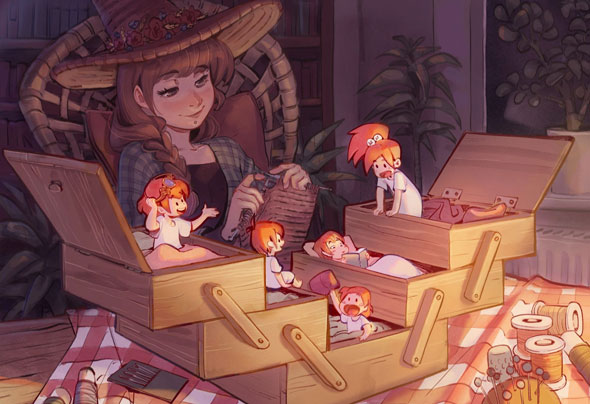
Have you noticed how the tiniest details can completely transform a piece of art?
Whether it’s a subtle texture in the background or a few carefully placed highlights, these small touches add depth and interest to your work! When done well, subtle details and textures can draw a viewer’s eye to key areas without overwhelming the composition. Today, we’ll look at how different artists strategically use details and textures to create stunning pieces!
With Philip Sue’s landscape art, the details added right at the end of his paintings is like the cherry on top of a cupcake. Textured brushes were used to paint interesting brushstrokes in the mountains and simple elements like rocks and shrubs brought this scenery to life! These subtle touches make the piece feel full of life without cluttering the scene!
Now, let’s look at another landscape example! Overall, we can see that Kenneth Anderson’s work has more detail than Philip Sue and yet, there’s still balance in the piece. Specifically, there is a balance between detail and simplicity.
Since the clouds, white dome base, and hills in the background have very little detail and almost no texture, our eyes are first drawn to the trees on top of the white dome—aka, where there is more detail. Our eyes might also dance around the areas with more texture, such as the waterfall and in the hills. A beautiful example of how to use texture to attract our eye to key areas!
Too much detail can shift focus away from the areas you want your viewers looking at. A strong character design will have a good balance of high detail and low detail! In Loish’s drawing above, she kept most of the detail in the upper portion of the design near the face, the main focal point!
Meike Schneider implemented texture early in her work using a textured brush. Take a look at how the shapes created with this brush (left picture) don’t have clean edges and the shapes aren’t perfectly filled in. The inside of these shapes are grainy and the edges break off. This is most noticeable in the hair. At the end of the piece, Meike painted blush to the skin with a grainy brush. The blush has more texture than the skin, drawing our attention to the cheeks!
Meike also strategically used detail to create visual interest in a few key areas. For example, she drew thin curly lines in the hair, details in the sunflower, and painted some darker lines to separate different parts of the body (i.e. the arm from the overalls), giving the piece more depth! The details are ever so small but they push the piece so much further!
Out of all of the styles we looked at today, Xiaofan Zhang’s work is by far the most detailed. Even so, she has her own way of adding finishing textures to the piece!
Since her work is fantasy based, there’s some liberty here to add detail in ways you normally wouldn’t be able to. What starts as a bright round sphere, Xiaofan transforms into a chaotic, energetic element using jagged lines with varying line weight and transparency. This magical sphere spreads out quite a bit, nearing the edge of the canvas. There are also white dots in the abyss, behind the character.
Xiaofan uses these textures to tell a story and to draw our attention to the center of the piece! As our eyes follow the magic towards the outer edges of the canvas, we find ourselves exploring the details of her clothing, headpiece, hair, etc.
The use of texture, though subtle, is an important tool to have in an artist’s toolbox. As it might seem like a small touch, adding texture can create so much visual interest to a piece. While textures aren’t essential for every style, it sure is powerful! The next time you’re at the end of a piece, think about where you might want to introduce a bit of texture—whether it’s in a landscape, a character, or something entirely unique.
Ready to dive deeper into digital illustration? Start with the FREE lessons in Simone Grunewald’s course, “Digital Illustration with Procreate!” Good luck artists!
Bree is a digital artist based in California. She enjoys helping new artists grow and loves to create artwork of her own.